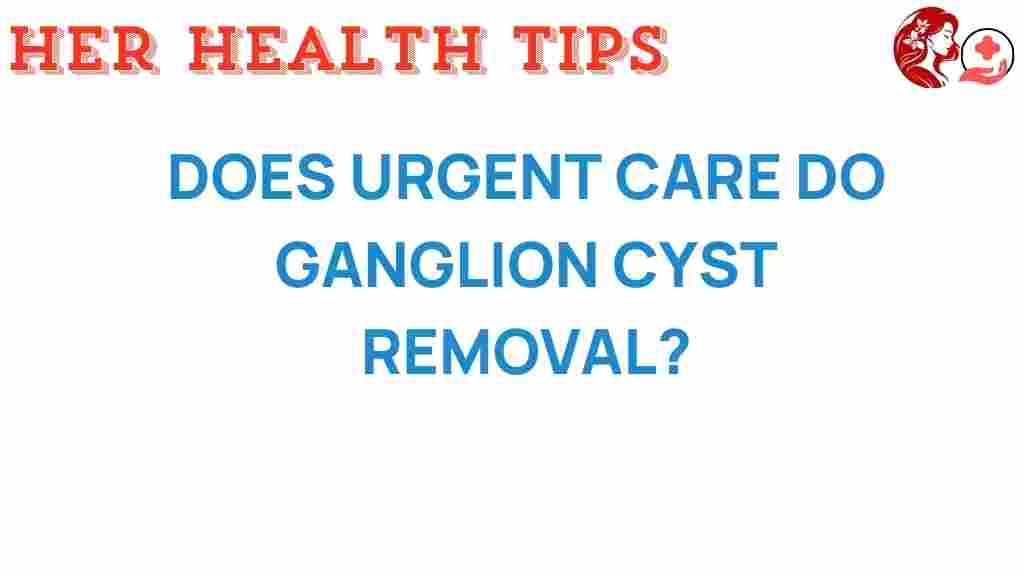Unraveling the Mystery: Can Urgent Care Remove Ganglion Cysts?
Ganglion cysts are fluid-filled sacs that often develop around joints and tendons, particularly in the hands and wrists. While they are typically benign and can resolve on their own, many individuals seek treatment for them due to discomfort or cosmetic concerns. One common question arises: can urgent care facilities remove ganglion cysts? In this article, we will explore this question, discuss various treatment options, and provide insights into the role of urgent care in managing ganglion cysts.
Understanding Ganglion Cysts
Before diving into the treatment options, it’s essential to understand what ganglion cysts are. These cysts form when synovial fluid leaks from a joint or tendon sheath and accumulates, creating a sac-like structure. They vary in size, can be painful, and may restrict movement depending on their location.
Symptoms of Ganglion Cysts
Ganglion cysts can present various symptoms, including:
- A noticeable lump under the skin
- Pain or discomfort, especially with movement
- Weakness in the affected area
- Numbness or tingling if they press on nerves
Seeking Treatment at Urgent Care
Urgent care facilities are designed to provide immediate, walk-in healthcare services for non-life-threatening conditions. Many people wonder whether urgent care can address their ganglion cyst concerns, particularly if they experience pain or discomfort.
Can Urgent Care Remove Ganglion Cysts?
The answer to this question is nuanced. While urgent care centers can provide initial evaluations and some treatment options for ganglion cysts, the actual removal typically requires a more specialized approach.
What Urgent Care Can Offer
At urgent care, healthcare providers can:
- Perform a physical examination to assess the cyst
- Provide pain relief through medication
- Guide patients on non-surgical treatment options
- Refer patients to orthopedic specialists for further evaluation and potential surgery
Non-Surgical Treatment Options
Many patients prefer to explore non-surgical options before considering removal. Below are some common non-surgical treatment options for ganglion cysts:
- Observation: In many cases, ganglion cysts can be monitored, especially if they are not causing significant symptoms.
- Splinting: Using a splint can help immobilize the affected area, reducing pain and irritation.
- Aspiration: This procedure involves using a needle to drain the fluid from the cyst. While this may provide temporary relief, the cyst can refill.
- Corticosteroid Injections: Injecting corticosteroids may help reduce inflammation and pain, although this does not guarantee the cyst will disappear.
When to Consider Surgical Removal
If non-surgical treatments do not provide relief, or if the ganglion cyst is causing significant pain or functional impairment, surgical removal may be necessary. Here’s a quick overview of when surgery might be considered:
- The cyst is large and bothersome.
- It causes persistent pain that affects daily activities.
- There are signs of nerve compression or other complications.
The Role of Orthopedic Specialists
If surgery is deemed necessary, urgent care providers will typically refer patients to orthopedic specialists. These healthcare professionals have specialized training in dealing with musculoskeletal issues, including ganglion cyst removal.
Understanding the Surgical Procedure
Surgical removal of a ganglion cyst is generally a straightforward procedure. Here’s what patients can expect:
Step-by-Step Process
- Consultation: The orthopedic specialist will review the patient’s medical history, perform an examination, and discuss the potential benefits and risks of surgery.
- Anesthesia: The procedure is usually performed under local anesthesia, ensuring the patient is comfortable and pain-free.
- Incision: The surgeon makes a small incision over the cyst.
- Removal: The cyst is carefully excised, including its base to reduce the chance of recurrence.
- Closure: The incision is closed with sutures, and the area is bandaged.
- Recovery: Patients are typically advised on post-operative care and when to follow up.
Post-Procedure Care
After the removal of a ganglion cyst, proper care is essential for a smooth recovery. Here are some tips for post-procedure care:
- Keep the area clean and dry.
- Follow any specific instructions given by the healthcare provider.
- Limit physical activity to allow for proper healing.
- Watch for signs of infection, such as increased redness, swelling, or discharge.
Troubleshooting Tips
Sometimes, patients may experience complications or concerns following cyst removal. Here are some troubleshooting tips:
- If pain persists, consult the healthcare provider for assessment.
- For swelling or bruising, apply ice and elevate the affected area.
- Contact the healthcare provider if there are signs of infection.
Conclusion
In conclusion, urgent care facilities play an important role in the initial evaluation and management of ganglion cysts. While they can provide non-surgical treatment options and referrals, surgical removal typically requires the expertise of an orthopedic specialist. Patients should consider their symptoms and explore all available treatment options, including non-surgical and surgical methods, to determine the best path for managing their ganglion cysts.
For more information on ganglion cysts and their treatment, consider visiting healthcare resources that specialize in patient care.
Whether you choose to pursue treatment at urgent care or consult an orthopedic specialist, understanding your options is key to effective management of ganglion cysts.
This article is in the category Conditions and created by HerHealthTips Team
